Analysis of Composite Leaf Spring for Automotive Applications
VerifiedAdded on 2023/06/04
|11
|4490
|467
Report
AI Summary
This report presents a comprehensive finite element analysis (FEA) of composite leaf springs, specifically designed for automotive vehicles. The study focuses on comparing the performance of composite leaf springs made of glass fiber reinforced polymer (E-glass/epoxy) with conventional steel leaf springs. The primary objective is to evaluate the load-carrying capacity, stiffness, and weight-saving potential of the composite alternative. The analysis utilizes ANSYS 14.5 software to conduct a 3-D FEA of the composite multi-leaf spring under full load conditions. The results are then compared with experimental data. The study also includes a literature review covering the application of leaf springs in automotive suspension systems, material properties of both steel and composite leaf springs, and the merits of using composite materials, such as reduced weight, improved damping capacity, and corrosion resistance. The methodology involves design selection, geometric modeling, and the application of specific assumptions to simplify the analysis. The findings demonstrate that composite leaf springs offer significant advantages over steel springs, including a substantial reduction in stress, increased stiffness frequency, and a considerable weight reduction, leading to improved fuel efficiency and vehicle performance.

ISSN(Online) :2319-8753
ISSN (Print) : 2347-6710
International Journal of Innovative Research in Science,
Engineering and Technology
(An ISO 3297: 2007 Certified Organization)
Vol. 4, Issue 8, August 2015
Copyright to IJIRSET DOI:10.15680/IJIRSET.2015.0408270 7757
Finite Element Analysis of Composite Leaf
Spring for Automotive Vehicle
N.Lenin Rakesh 1, G R Kaushik2, Dr. J. Hameed Hussain3
1Assistant Professor, Department of Mechanical Engineering, Bharath University, Chennai, India
2Student, Department of Mechanical Engineering, Bharath University, Chennai, India
3Professor, Department of Mechanical Engineering, Bharath University, Chennai, India
ABSTRACT: Reducing weight while increasing or maintaining strength of products is getting to be highly important.
The Automobile Industry has great interest for replacement of steel leaf spring with that of composite leaf
spring , The objective is to compare the stresses and weight saving of composite leaf spring with that of steel
leaf spring since the composite materials has high strength to weight ratio, good corrosion resistance. The
material selected was glass fibre reinforced polymer (E glass/epoxy), it is used against Conventional steel..
I.INTRODUCTION
Weight reduction has been the main focus of automobile manufacturers in the present scenario. Weight
reduction can be achieved primarily by the introduction of better material, design optimization and better
manufacturing processes. The suspension leaf spring is one of the potential items for weight reduction in
automobiles as it accounts for 10% - 20% of the unsprung weight. This achieves the vehicle more fuel efficiency
and improved riding qualities.
The leaf spring should absorb the vertical vibrations and impacts due to road irregularities
by means of variations in the spring deflection so that the potential Energy is stored in spring as strain energy and
then released slowly. So, increasing the energy storage capability of a leaf spring ensures a more compliant
suspension system.
According to the studies a material made with maximum strength and minimum modulus of
elasticity in the longitudinal direction is the most suitable material for a leaf spring. The leaf springs are more
affected due to fatigue loads, as they are a part of the unsprang mass of the automobile.
In the present work, a normal leaf steel spring used in passenger cars or light duty vehicles is replaced
with a composite multi leaf spring made of glass/epoxy composites. The dimensions and the number of leaves
for both steel leaf spring and composite leaf springs are considered to be the same.
II.OBJECTIVE
This project describes design and experimental analysis of composite leaf spring made of glass
fibre reinforced polymer. The objective is to compare the load carrying capacity, stiffness and weight savings
of composite leaf spring with that of steel leaf spring.
Finite element analysis with full load on 3-D model of composite multi leaf spring is done using
ANSYS 14.5 and the analytical results are compared with experimental results. Compared to steel spring, the
composite leaf spring is found to have 67.35% lesser stress, 64.95% higher stiffness frequency than that of existing
steel leaf spring. A weight reduction of 66.8% is achieved by using optimized composite leaf spring.
III.LITERATURE SURVEY
LEAF SPRING:
Leaf springs are mainly used in suspension systems to absorb shock loads in automobiles like light
motor vehicles, heavy duty trucks and in rail systems. It carries lateral loads, brake torque, driving torque in addition to
ISSN (Print) : 2347-6710
International Journal of Innovative Research in Science,
Engineering and Technology
(An ISO 3297: 2007 Certified Organization)
Vol. 4, Issue 8, August 2015
Copyright to IJIRSET DOI:10.15680/IJIRSET.2015.0408270 7757
Finite Element Analysis of Composite Leaf
Spring for Automotive Vehicle
N.Lenin Rakesh 1, G R Kaushik2, Dr. J. Hameed Hussain3
1Assistant Professor, Department of Mechanical Engineering, Bharath University, Chennai, India
2Student, Department of Mechanical Engineering, Bharath University, Chennai, India
3Professor, Department of Mechanical Engineering, Bharath University, Chennai, India
ABSTRACT: Reducing weight while increasing or maintaining strength of products is getting to be highly important.
The Automobile Industry has great interest for replacement of steel leaf spring with that of composite leaf
spring , The objective is to compare the stresses and weight saving of composite leaf spring with that of steel
leaf spring since the composite materials has high strength to weight ratio, good corrosion resistance. The
material selected was glass fibre reinforced polymer (E glass/epoxy), it is used against Conventional steel..
I.INTRODUCTION
Weight reduction has been the main focus of automobile manufacturers in the present scenario. Weight
reduction can be achieved primarily by the introduction of better material, design optimization and better
manufacturing processes. The suspension leaf spring is one of the potential items for weight reduction in
automobiles as it accounts for 10% - 20% of the unsprung weight. This achieves the vehicle more fuel efficiency
and improved riding qualities.
The leaf spring should absorb the vertical vibrations and impacts due to road irregularities
by means of variations in the spring deflection so that the potential Energy is stored in spring as strain energy and
then released slowly. So, increasing the energy storage capability of a leaf spring ensures a more compliant
suspension system.
According to the studies a material made with maximum strength and minimum modulus of
elasticity in the longitudinal direction is the most suitable material for a leaf spring. The leaf springs are more
affected due to fatigue loads, as they are a part of the unsprang mass of the automobile.
In the present work, a normal leaf steel spring used in passenger cars or light duty vehicles is replaced
with a composite multi leaf spring made of glass/epoxy composites. The dimensions and the number of leaves
for both steel leaf spring and composite leaf springs are considered to be the same.
II.OBJECTIVE
This project describes design and experimental analysis of composite leaf spring made of glass
fibre reinforced polymer. The objective is to compare the load carrying capacity, stiffness and weight savings
of composite leaf spring with that of steel leaf spring.
Finite element analysis with full load on 3-D model of composite multi leaf spring is done using
ANSYS 14.5 and the analytical results are compared with experimental results. Compared to steel spring, the
composite leaf spring is found to have 67.35% lesser stress, 64.95% higher stiffness frequency than that of existing
steel leaf spring. A weight reduction of 66.8% is achieved by using optimized composite leaf spring.
III.LITERATURE SURVEY
LEAF SPRING:
Leaf springs are mainly used in suspension systems to absorb shock loads in automobiles like light
motor vehicles, heavy duty trucks and in rail systems. It carries lateral loads, brake torque, driving torque in addition to
Paraphrase This Document
Need a fresh take? Get an instant paraphrase of this document with our AI Paraphraser
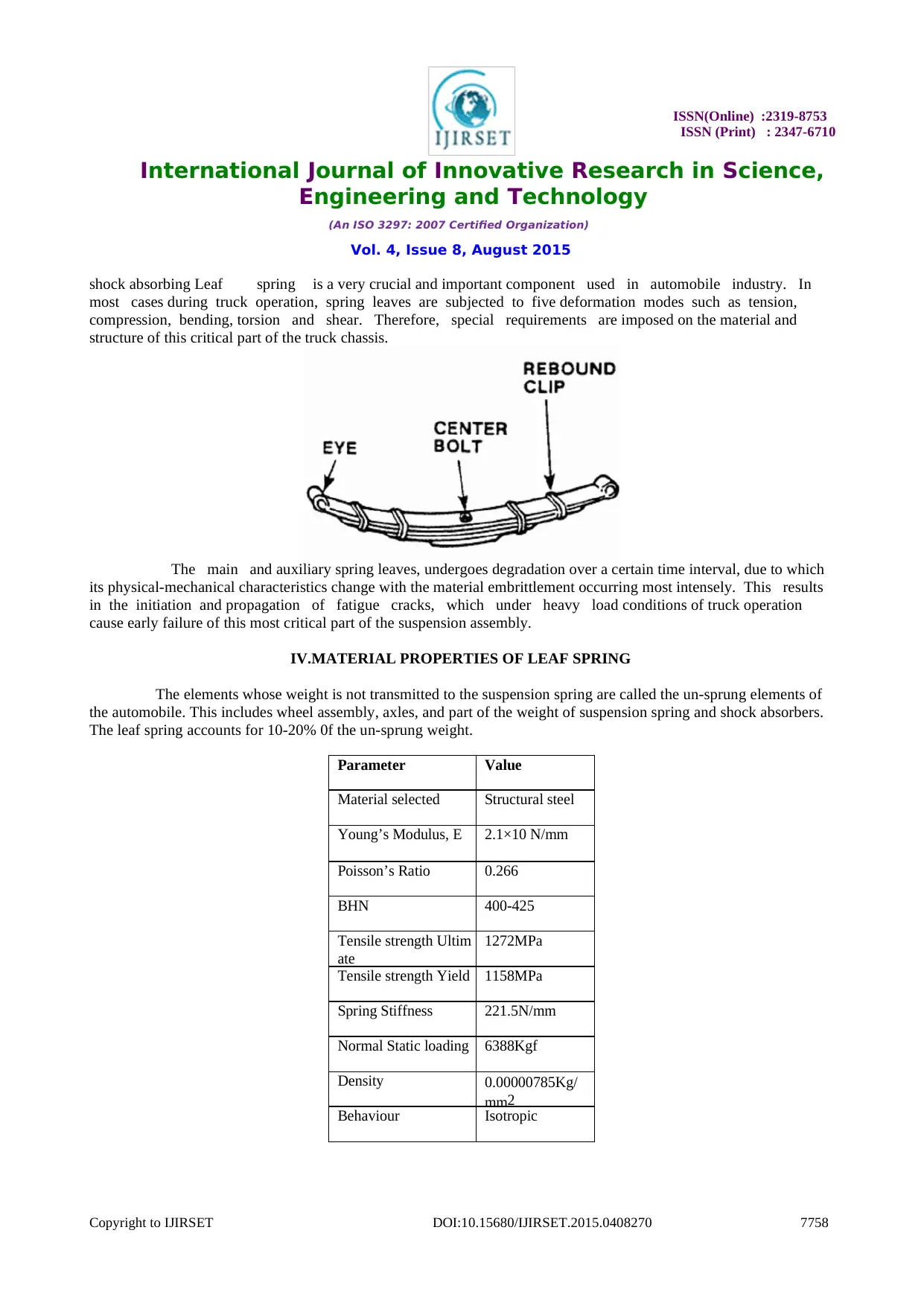
ISSN(Online) :2319-8753
ISSN (Print) : 2347-6710
International Journal of Innovative Research in Science,
Engineering and Technology
(An ISO 3297: 2007 Certified Organization)
Vol. 4, Issue 8, August 2015
Copyright to IJIRSET DOI:10.15680/IJIRSET.2015.0408270 7758
shock absorbing Leaf spring is a very crucial and important component used in automobile industry. In
most cases during truck operation, spring leaves are subjected to five deformation modes such as tension,
compression, bending, torsion and shear. Therefore, special requirements are imposed on the material and
structure of this critical part of the truck chassis.
The main and auxiliary spring leaves, undergoes degradation over a certain time interval, due to which
its physical-mechanical characteristics change with the material embrittlement occurring most intensely. This results
in the initiation and propagation of fatigue cracks, which under heavy load conditions of truck operation
cause early failure of this most critical part of the suspension assembly.
IV.MATERIAL PROPERTIES OF LEAF SPRING
The elements whose weight is not transmitted to the suspension spring are called the un-sprung elements of
the automobile. This includes wheel assembly, axles, and part of the weight of suspension spring and shock absorbers.
The leaf spring accounts for 10-20% 0f the un-sprung weight.
Parameter Value
Material selected Structural steel
Young’s Modulus, E 2.1×10 N/mm
Poisson’s Ratio 0.266
BHN 400-425
Tensile strength Ultim
ate
1272MPa
Tensile strength Yield 1158MPa
Spring Stiffness 221.5N/mm
Normal Static loading 6388Kgf
Density 0.00000785Kg/
mm2
Behaviour Isotropic
ISSN (Print) : 2347-6710
International Journal of Innovative Research in Science,
Engineering and Technology
(An ISO 3297: 2007 Certified Organization)
Vol. 4, Issue 8, August 2015
Copyright to IJIRSET DOI:10.15680/IJIRSET.2015.0408270 7758
shock absorbing Leaf spring is a very crucial and important component used in automobile industry. In
most cases during truck operation, spring leaves are subjected to five deformation modes such as tension,
compression, bending, torsion and shear. Therefore, special requirements are imposed on the material and
structure of this critical part of the truck chassis.
The main and auxiliary spring leaves, undergoes degradation over a certain time interval, due to which
its physical-mechanical characteristics change with the material embrittlement occurring most intensely. This results
in the initiation and propagation of fatigue cracks, which under heavy load conditions of truck operation
cause early failure of this most critical part of the suspension assembly.
IV.MATERIAL PROPERTIES OF LEAF SPRING
The elements whose weight is not transmitted to the suspension spring are called the un-sprung elements of
the automobile. This includes wheel assembly, axles, and part of the weight of suspension spring and shock absorbers.
The leaf spring accounts for 10-20% 0f the un-sprung weight.
Parameter Value
Material selected Structural steel
Young’s Modulus, E 2.1×10 N/mm
Poisson’s Ratio 0.266
BHN 400-425
Tensile strength Ultim
ate
1272MPa
Tensile strength Yield 1158MPa
Spring Stiffness 221.5N/mm
Normal Static loading 6388Kgf
Density 0.00000785Kg/
mm2
Behaviour Isotropic
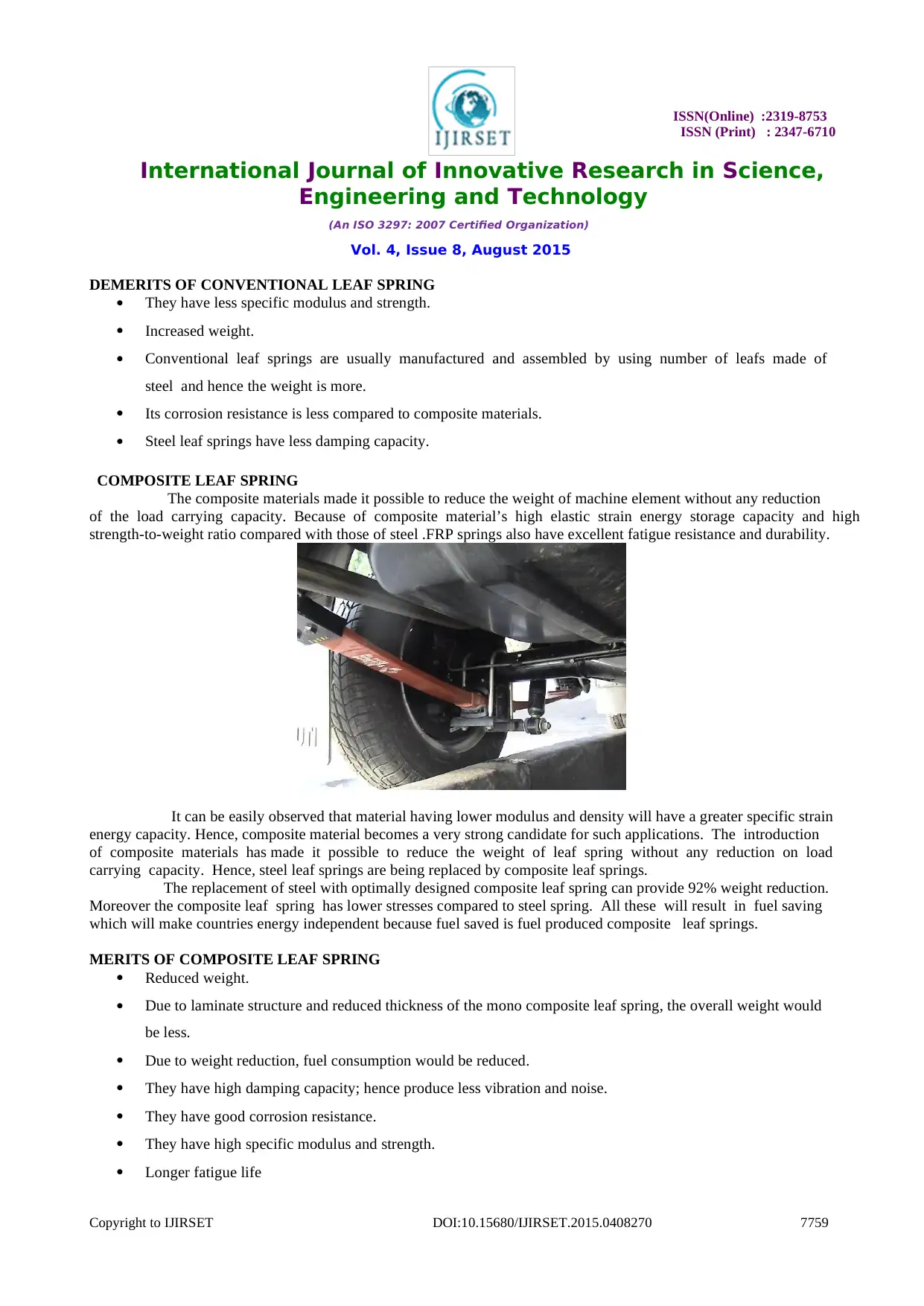
ISSN(Online) :2319-8753
ISSN (Print) : 2347-6710
International Journal of Innovative Research in Science,
Engineering and Technology
(An ISO 3297: 2007 Certified Organization)
Vol. 4, Issue 8, August 2015
Copyright to IJIRSET DOI:10.15680/IJIRSET.2015.0408270 7759
DEMERITS OF CONVENTIONAL LEAF SPRING
They have less specific modulus and strength.
Increased weight.
Conventional leaf springs are usually manufactured and assembled by using number of leafs made of
steel and hence the weight is more.
Its corrosion resistance is less compared to composite materials.
Steel leaf springs have less damping capacity.
COMPOSITE LEAF SPRING
The composite materials made it possible to reduce the weight of machine element without any reduction
of the load carrying capacity. Because of composite material’s high elastic strain energy storage capacity and high
strength-to-weight ratio compared with those of steel .FRP springs also have excellent fatigue resistance and durability.
It can be easily observed that material having lower modulus and density will have a greater specific strain
energy capacity. Hence, composite material becomes a very strong candidate for such applications. The introduction
of composite materials has made it possible to reduce the weight of leaf spring without any reduction on load
carrying capacity. Hence, steel leaf springs are being replaced by composite leaf springs.
The replacement of steel with optimally designed composite leaf spring can provide 92% weight reduction.
Moreover the composite leaf spring has lower stresses compared to steel spring. All these will result in fuel saving
which will make countries energy independent because fuel saved is fuel produced composite leaf springs.
MERITS OF COMPOSITE LEAF SPRING
Reduced weight.
Due to laminate structure and reduced thickness of the mono composite leaf spring, the overall weight would
be less.
Due to weight reduction, fuel consumption would be reduced.
They have high damping capacity; hence produce less vibration and noise.
They have good corrosion resistance.
They have high specific modulus and strength.
Longer fatigue life
ISSN (Print) : 2347-6710
International Journal of Innovative Research in Science,
Engineering and Technology
(An ISO 3297: 2007 Certified Organization)
Vol. 4, Issue 8, August 2015
Copyright to IJIRSET DOI:10.15680/IJIRSET.2015.0408270 7759
DEMERITS OF CONVENTIONAL LEAF SPRING
They have less specific modulus and strength.
Increased weight.
Conventional leaf springs are usually manufactured and assembled by using number of leafs made of
steel and hence the weight is more.
Its corrosion resistance is less compared to composite materials.
Steel leaf springs have less damping capacity.
COMPOSITE LEAF SPRING
The composite materials made it possible to reduce the weight of machine element without any reduction
of the load carrying capacity. Because of composite material’s high elastic strain energy storage capacity and high
strength-to-weight ratio compared with those of steel .FRP springs also have excellent fatigue resistance and durability.
It can be easily observed that material having lower modulus and density will have a greater specific strain
energy capacity. Hence, composite material becomes a very strong candidate for such applications. The introduction
of composite materials has made it possible to reduce the weight of leaf spring without any reduction on load
carrying capacity. Hence, steel leaf springs are being replaced by composite leaf springs.
The replacement of steel with optimally designed composite leaf spring can provide 92% weight reduction.
Moreover the composite leaf spring has lower stresses compared to steel spring. All these will result in fuel saving
which will make countries energy independent because fuel saved is fuel produced composite leaf springs.
MERITS OF COMPOSITE LEAF SPRING
Reduced weight.
Due to laminate structure and reduced thickness of the mono composite leaf spring, the overall weight would
be less.
Due to weight reduction, fuel consumption would be reduced.
They have high damping capacity; hence produce less vibration and noise.
They have good corrosion resistance.
They have high specific modulus and strength.
Longer fatigue life
⊘ This is a preview!⊘
Do you want full access?
Subscribe today to unlock all pages.

Trusted by 1+ million students worldwide
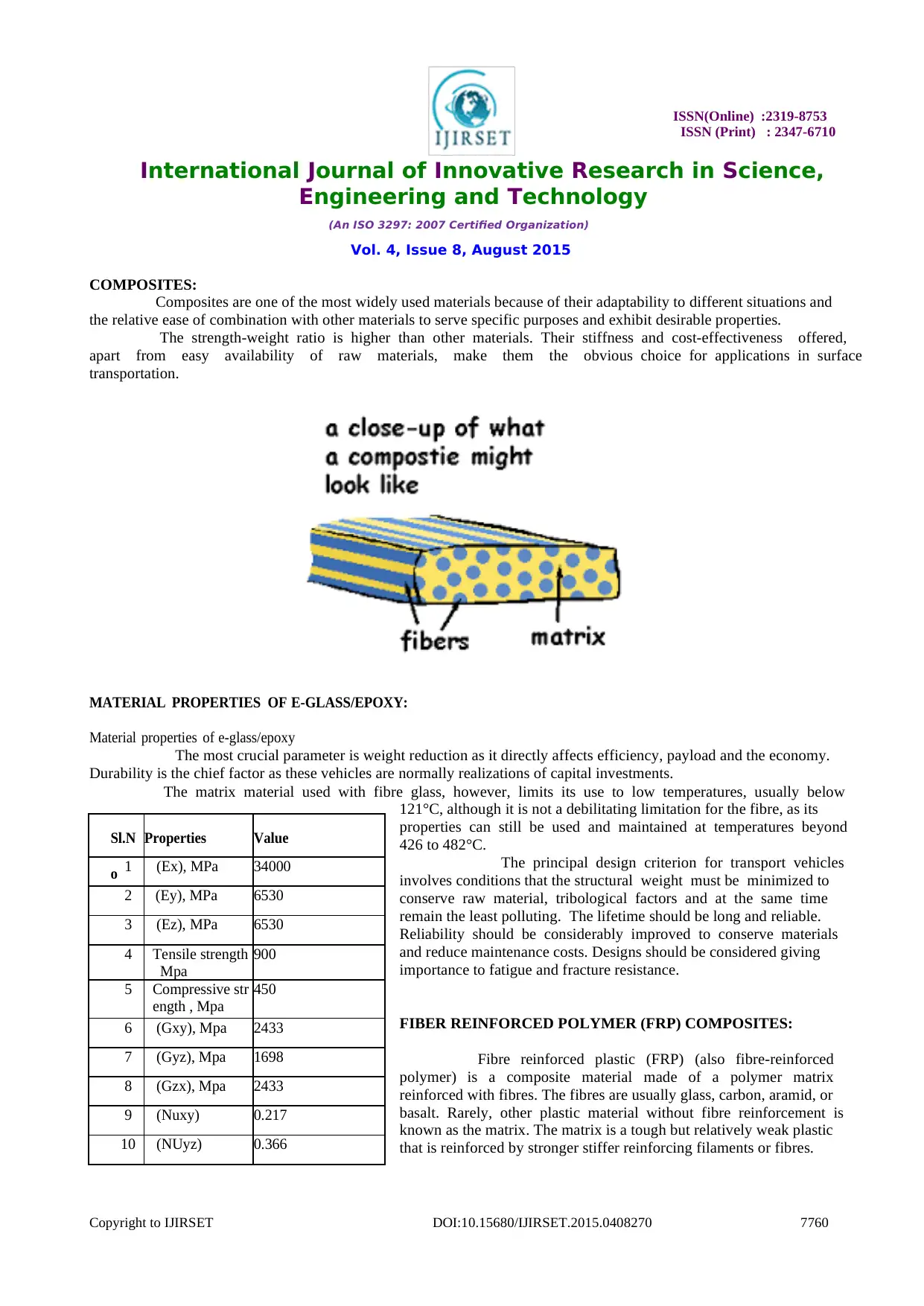
ISSN(Online) :2319-8753
ISSN (Print) : 2347-6710
International Journal of Innovative Research in Science,
Engineering and Technology
(An ISO 3297: 2007 Certified Organization)
Vol. 4, Issue 8, August 2015
Copyright to IJIRSET DOI:10.15680/IJIRSET.2015.0408270 7760
COMPOSITES:
Composites are one of the most widely used materials because of their adaptability to different situations and
the relative ease of combination with other materials to serve specific purposes and exhibit desirable properties.
The strength-weight ratio is higher than other materials. Their stiffness and cost-effectiveness offered,
apart from easy availability of raw materials, make them the obvious choice for applications in surface
transportation.
MATERIAL PROPERTIES OF E-GLASS/EPOXY:
Material properties of e-glass/epoxy
The most crucial parameter is weight reduction as it directly affects efficiency, payload and the economy.
Durability is the chief factor as these vehicles are normally realizations of capital investments.
The matrix material used with fibre glass, however, limits its use to low temperatures, usually below
121°C, although it is not a debilitating limitation for the fibre, as its
properties can still be used and maintained at temperatures beyond
426 to 482°C.
The principal design criterion for transport vehicles
involves conditions that the structural weight must be minimized to
conserve raw material, tribological factors and at the same time
remain the least polluting. The lifetime should be long and reliable.
Reliability should be considerably improved to conserve materials
and reduce maintenance costs. Designs should be considered giving
importance to fatigue and fracture resistance.
FIBER REINFORCED POLYMER (FRP) COMPOSITES:
Fibre reinforced plastic (FRP) (also fibre-reinforced
polymer) is a composite material made of a polymer matrix
reinforced with fibres. The fibres are usually glass, carbon, aramid, or
basalt. Rarely, other plastic material without fibre reinforcement is
known as the matrix. The matrix is a tough but relatively weak plastic
that is reinforced by stronger stiffer reinforcing filaments or fibres.
Sl.N
o
Properties Value
1 (Ex), MPa 34000
2 (Ey), MPa 6530
3 (Ez), MPa 6530
4 Tensile strength
Mpa
900
5 Compressive str
ength , Mpa
450
6 (Gxy), Mpa 2433
7 (Gyz), Mpa 1698
8 (Gzx), Mpa 2433
9 (Nuxy) 0.217
10 (NUyz) 0.366
ISSN (Print) : 2347-6710
International Journal of Innovative Research in Science,
Engineering and Technology
(An ISO 3297: 2007 Certified Organization)
Vol. 4, Issue 8, August 2015
Copyright to IJIRSET DOI:10.15680/IJIRSET.2015.0408270 7760
COMPOSITES:
Composites are one of the most widely used materials because of their adaptability to different situations and
the relative ease of combination with other materials to serve specific purposes and exhibit desirable properties.
The strength-weight ratio is higher than other materials. Their stiffness and cost-effectiveness offered,
apart from easy availability of raw materials, make them the obvious choice for applications in surface
transportation.
MATERIAL PROPERTIES OF E-GLASS/EPOXY:
Material properties of e-glass/epoxy
The most crucial parameter is weight reduction as it directly affects efficiency, payload and the economy.
Durability is the chief factor as these vehicles are normally realizations of capital investments.
The matrix material used with fibre glass, however, limits its use to low temperatures, usually below
121°C, although it is not a debilitating limitation for the fibre, as its
properties can still be used and maintained at temperatures beyond
426 to 482°C.
The principal design criterion for transport vehicles
involves conditions that the structural weight must be minimized to
conserve raw material, tribological factors and at the same time
remain the least polluting. The lifetime should be long and reliable.
Reliability should be considerably improved to conserve materials
and reduce maintenance costs. Designs should be considered giving
importance to fatigue and fracture resistance.
FIBER REINFORCED POLYMER (FRP) COMPOSITES:
Fibre reinforced plastic (FRP) (also fibre-reinforced
polymer) is a composite material made of a polymer matrix
reinforced with fibres. The fibres are usually glass, carbon, aramid, or
basalt. Rarely, other plastic material without fibre reinforcement is
known as the matrix. The matrix is a tough but relatively weak plastic
that is reinforced by stronger stiffer reinforcing filaments or fibres.
Sl.N
o
Properties Value
1 (Ex), MPa 34000
2 (Ey), MPa 6530
3 (Ez), MPa 6530
4 Tensile strength
Mpa
900
5 Compressive str
ength , Mpa
450
6 (Gxy), Mpa 2433
7 (Gyz), Mpa 1698
8 (Gzx), Mpa 2433
9 (Nuxy) 0.217
10 (NUyz) 0.366
Paraphrase This Document
Need a fresh take? Get an instant paraphrase of this document with our AI Paraphraser
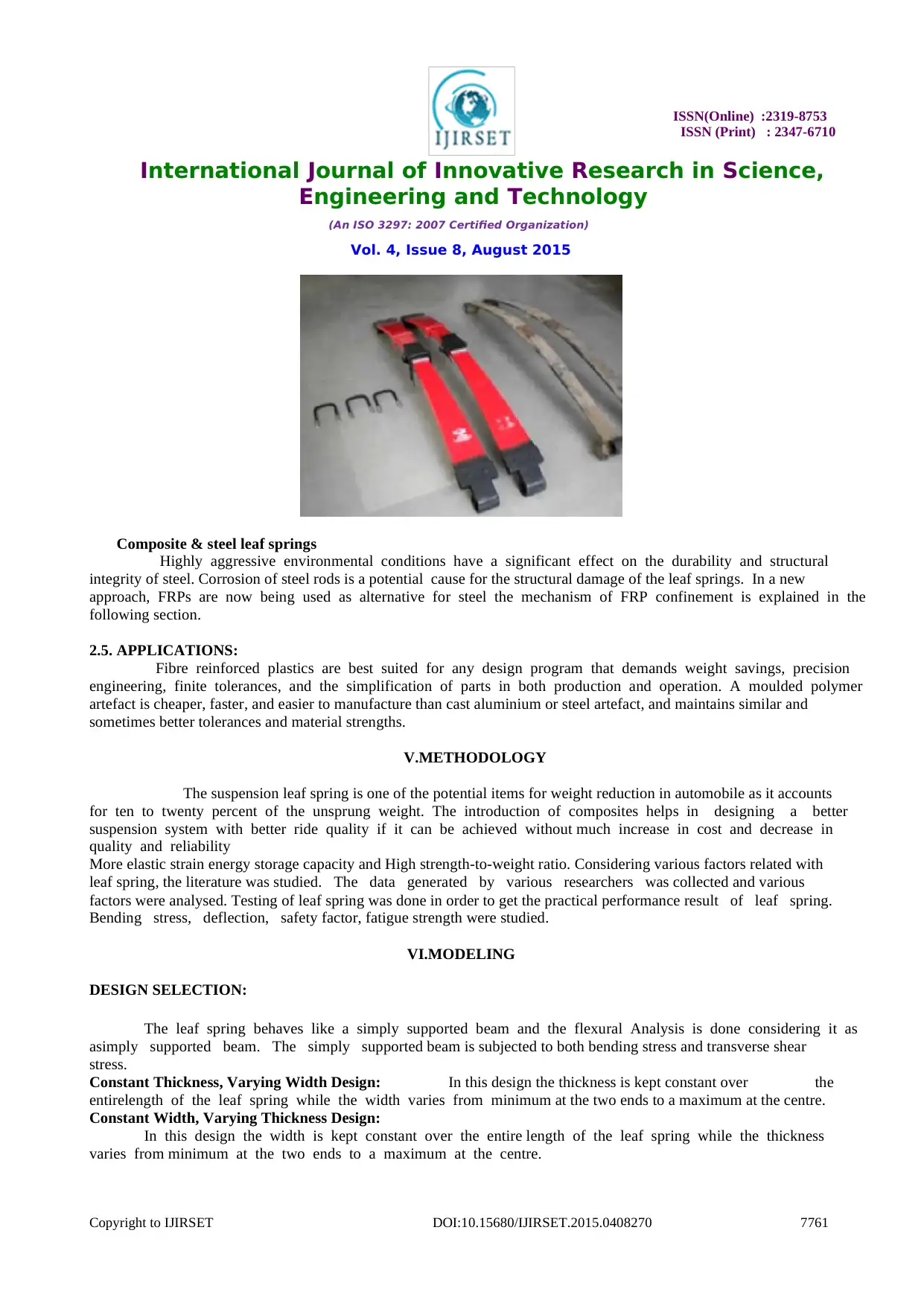
ISSN(Online) :2319-8753
ISSN (Print) : 2347-6710
International Journal of Innovative Research in Science,
Engineering and Technology
(An ISO 3297: 2007 Certified Organization)
Vol. 4, Issue 8, August 2015
Copyright to IJIRSET DOI:10.15680/IJIRSET.2015.0408270 7761
Composite & steel leaf springs
Highly aggressive environmental conditions have a significant effect on the durability and structural
integrity of steel. Corrosion of steel rods is a potential cause for the structural damage of the leaf springs. In a new
approach, FRPs are now being used as alternative for steel the mechanism of FRP confinement is explained in the
following section.
2.5. APPLICATIONS:
Fibre reinforced plastics are best suited for any design program that demands weight savings, precision
engineering, finite tolerances, and the simplification of parts in both production and operation. A moulded polymer
artefact is cheaper, faster, and easier to manufacture than cast aluminium or steel artefact, and maintains similar and
sometimes better tolerances and material strengths.
V.METHODOLOGY
The suspension leaf spring is one of the potential items for weight reduction in automobile as it accounts
for ten to twenty percent of the unsprung weight. The introduction of composites helps in designing a better
suspension system with better ride quality if it can be achieved without much increase in cost and decrease in
quality and reliability
More elastic strain energy storage capacity and High strength-to-weight ratio. Considering various factors related with
leaf spring, the literature was studied. The data generated by various researchers was collected and various
factors were analysed. Testing of leaf spring was done in order to get the practical performance result of leaf spring.
Bending stress, deflection, safety factor, fatigue strength were studied.
VI.MODELING
DESIGN SELECTION:
The leaf spring behaves like a simply supported beam and the flexural Analysis is done considering it as
asimply supported beam. The simply supported beam is subjected to both bending stress and transverse shear
stress.
Constant Thickness, Varying Width Design: In this design the thickness is kept constant over the
entirelength of the leaf spring while the width varies from minimum at the two ends to a maximum at the centre.
Constant Width, Varying Thickness Design:
In this design the width is kept constant over the entire length of the leaf spring while the thickness
varies from minimum at the two ends to a maximum at the centre.
ISSN (Print) : 2347-6710
International Journal of Innovative Research in Science,
Engineering and Technology
(An ISO 3297: 2007 Certified Organization)
Vol. 4, Issue 8, August 2015
Copyright to IJIRSET DOI:10.15680/IJIRSET.2015.0408270 7761
Composite & steel leaf springs
Highly aggressive environmental conditions have a significant effect on the durability and structural
integrity of steel. Corrosion of steel rods is a potential cause for the structural damage of the leaf springs. In a new
approach, FRPs are now being used as alternative for steel the mechanism of FRP confinement is explained in the
following section.
2.5. APPLICATIONS:
Fibre reinforced plastics are best suited for any design program that demands weight savings, precision
engineering, finite tolerances, and the simplification of parts in both production and operation. A moulded polymer
artefact is cheaper, faster, and easier to manufacture than cast aluminium or steel artefact, and maintains similar and
sometimes better tolerances and material strengths.
V.METHODOLOGY
The suspension leaf spring is one of the potential items for weight reduction in automobile as it accounts
for ten to twenty percent of the unsprung weight. The introduction of composites helps in designing a better
suspension system with better ride quality if it can be achieved without much increase in cost and decrease in
quality and reliability
More elastic strain energy storage capacity and High strength-to-weight ratio. Considering various factors related with
leaf spring, the literature was studied. The data generated by various researchers was collected and various
factors were analysed. Testing of leaf spring was done in order to get the practical performance result of leaf spring.
Bending stress, deflection, safety factor, fatigue strength were studied.
VI.MODELING
DESIGN SELECTION:
The leaf spring behaves like a simply supported beam and the flexural Analysis is done considering it as
asimply supported beam. The simply supported beam is subjected to both bending stress and transverse shear
stress.
Constant Thickness, Varying Width Design: In this design the thickness is kept constant over the
entirelength of the leaf spring while the width varies from minimum at the two ends to a maximum at the centre.
Constant Width, Varying Thickness Design:
In this design the width is kept constant over the entire length of the leaf spring while the thickness
varies from minimum at the two ends to a maximum at the centre.
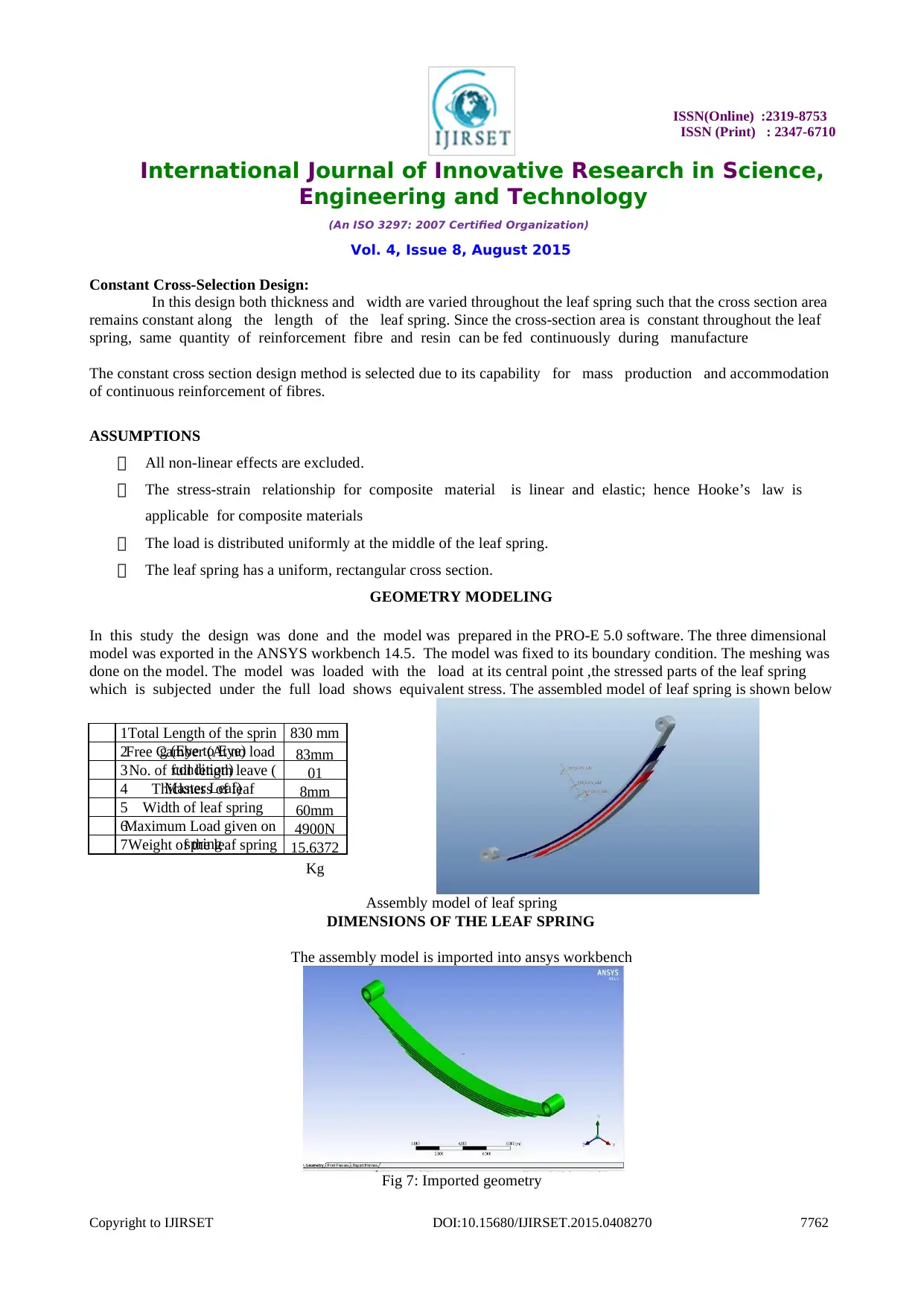
ISSN(Online) :2319-8753
ISSN (Print) : 2347-6710
International Journal of Innovative Research in Science,
Engineering and Technology
(An ISO 3297: 2007 Certified Organization)
Vol. 4, Issue 8, August 2015
Copyright to IJIRSET DOI:10.15680/IJIRSET.2015.0408270 7762
Constant Cross-Selection Design:
In this design both thickness and width are varied throughout the leaf spring such that the cross section area
remains constant along the length of the leaf spring. Since the cross-section area is constant throughout the leaf
spring, same quantity of reinforcement fibre and resin can be fed continuously during manufacture
The constant cross section design method is selected due to its capability for mass production and accommodation
of continuous reinforcement of fibres.
ASSUMPTIONS
All non-linear effects are excluded.
The stress-strain relationship for composite material is linear and elastic; hence Hooke’s law is
applicable for composite materials
The load is distributed uniformly at the middle of the leaf spring.
The leaf spring has a uniform, rectangular cross section.
GEOMETRY MODELING
In this study the design was done and the model was prepared in the PRO-E 5.0 software. The three dimensional
model was exported in the ANSYS workbench 14.5. The model was fixed to its boundary condition. The meshing was
done on the model. The model was loaded with the load at its central point ,the stressed parts of the leaf spring
which is subjected under the full load shows equivalent stress. The assembled model of leaf spring is shown below
Assembly model of leaf spring
DIMENSIONS OF THE LEAF SPRING
The assembly model is imported into ansys workbench
Fig 7: Imported geometry
1Total Length of the sprin
g (Eye to Eye)
830 mm
2Free Camber (At no load
condition) 83mm
3 No. of full length leave (
Master Leaf) 01
4 Thickness of leaf 8mm
5 Width of leaf spring 60mm
6Maximum Load given on
spring 4900N
7Weight of the leaf spring 15.6372
Kg
ISSN (Print) : 2347-6710
International Journal of Innovative Research in Science,
Engineering and Technology
(An ISO 3297: 2007 Certified Organization)
Vol. 4, Issue 8, August 2015
Copyright to IJIRSET DOI:10.15680/IJIRSET.2015.0408270 7762
Constant Cross-Selection Design:
In this design both thickness and width are varied throughout the leaf spring such that the cross section area
remains constant along the length of the leaf spring. Since the cross-section area is constant throughout the leaf
spring, same quantity of reinforcement fibre and resin can be fed continuously during manufacture
The constant cross section design method is selected due to its capability for mass production and accommodation
of continuous reinforcement of fibres.
ASSUMPTIONS
All non-linear effects are excluded.
The stress-strain relationship for composite material is linear and elastic; hence Hooke’s law is
applicable for composite materials
The load is distributed uniformly at the middle of the leaf spring.
The leaf spring has a uniform, rectangular cross section.
GEOMETRY MODELING
In this study the design was done and the model was prepared in the PRO-E 5.0 software. The three dimensional
model was exported in the ANSYS workbench 14.5. The model was fixed to its boundary condition. The meshing was
done on the model. The model was loaded with the load at its central point ,the stressed parts of the leaf spring
which is subjected under the full load shows equivalent stress. The assembled model of leaf spring is shown below
Assembly model of leaf spring
DIMENSIONS OF THE LEAF SPRING
The assembly model is imported into ansys workbench
Fig 7: Imported geometry
1Total Length of the sprin
g (Eye to Eye)
830 mm
2Free Camber (At no load
condition) 83mm
3 No. of full length leave (
Master Leaf) 01
4 Thickness of leaf 8mm
5 Width of leaf spring 60mm
6Maximum Load given on
spring 4900N
7Weight of the leaf spring 15.6372
Kg
⊘ This is a preview!⊘
Do you want full access?
Subscribe today to unlock all pages.

Trusted by 1+ million students worldwide

ISSN(Online) :2319-8753
ISSN (Print) : 2347-6710
International Journal of Innovative Research in Science,
Engineering and Technology
(An ISO 3297: 2007 Certified Organization)
Vol. 4, Issue 8, August 2015
Copyright to IJIRSET DOI:10.15680/IJIRSET.2015.0408270 7763
Setting up contact points & boundary conditions:
Contact points & boundary conditions are set for the leaf spring model
Fig 8: Contact points
MESHING:
Fig 9: meshing of leaf spring
POST PROCESSING
In order to validate the design parameters, FEA is performed using ANSYS Workbench 14. One side of the
model is completely fixed (cantilever) and the free end is subjected to a force of in vertically downward direction. A
maximum load of 4900N is applied at the central point on the final layer of leaf spring.
Leaf n
o Full leaf
length (
mm) 2L
Half leaf le
ngth(mm)
L
Radius of
curvatur
e R (mm)
1 830 415 1078
2 714 357 1086
3 578 286 1094
4 490 245 1102
5 412 206 1110
ISSN (Print) : 2347-6710
International Journal of Innovative Research in Science,
Engineering and Technology
(An ISO 3297: 2007 Certified Organization)
Vol. 4, Issue 8, August 2015
Copyright to IJIRSET DOI:10.15680/IJIRSET.2015.0408270 7763
Setting up contact points & boundary conditions:
Contact points & boundary conditions are set for the leaf spring model
Fig 8: Contact points
MESHING:
Fig 9: meshing of leaf spring
POST PROCESSING
In order to validate the design parameters, FEA is performed using ANSYS Workbench 14. One side of the
model is completely fixed (cantilever) and the free end is subjected to a force of in vertically downward direction. A
maximum load of 4900N is applied at the central point on the final layer of leaf spring.
Leaf n
o Full leaf
length (
mm) 2L
Half leaf le
ngth(mm)
L
Radius of
curvatur
e R (mm)
1 830 415 1078
2 714 357 1086
3 578 286 1094
4 490 245 1102
5 412 206 1110
Paraphrase This Document
Need a fresh take? Get an instant paraphrase of this document with our AI Paraphraser
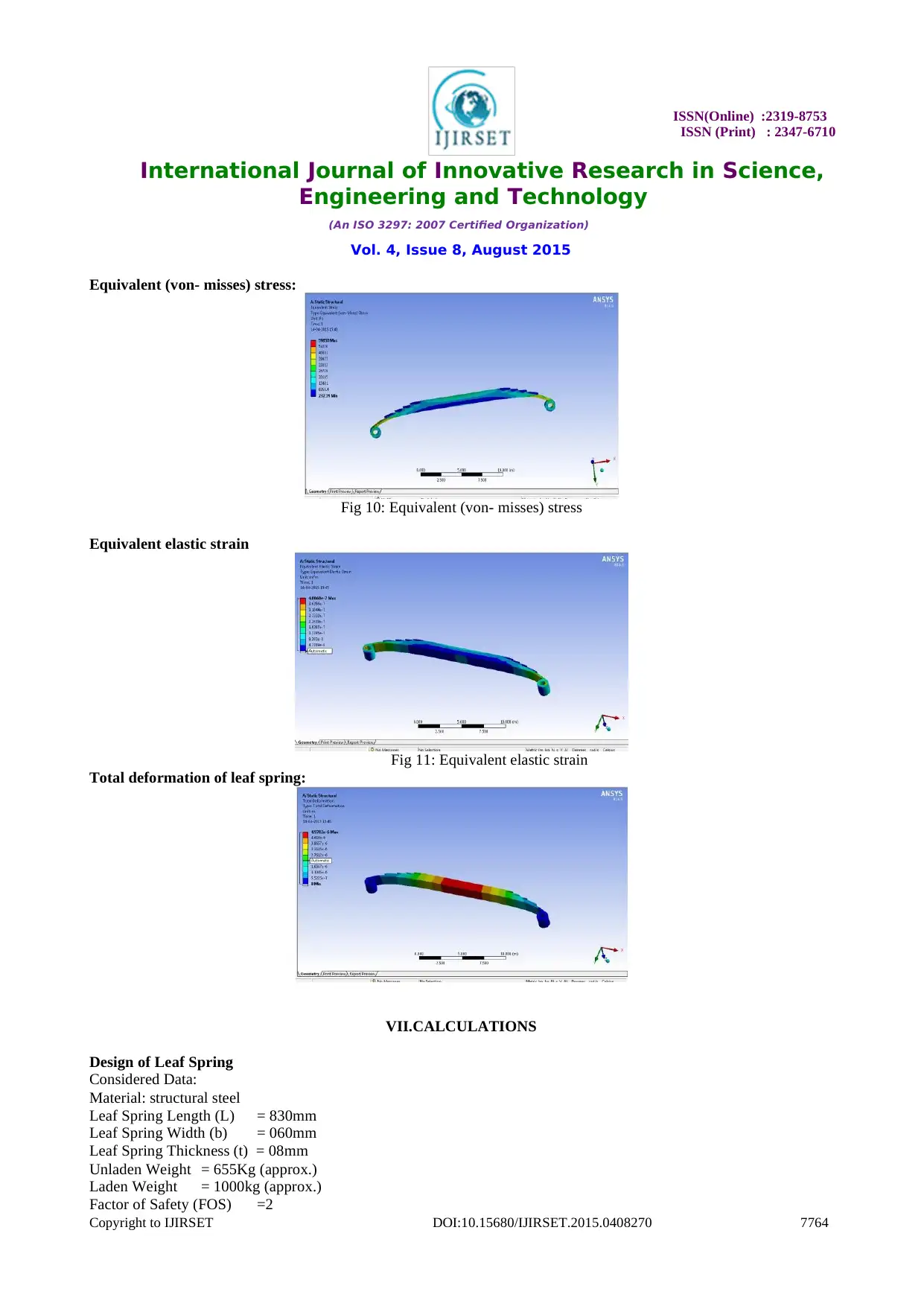
ISSN(Online) :2319-8753
ISSN (Print) : 2347-6710
International Journal of Innovative Research in Science,
Engineering and Technology
(An ISO 3297: 2007 Certified Organization)
Vol. 4, Issue 8, August 2015
Copyright to IJIRSET DOI:10.15680/IJIRSET.2015.0408270 7764
Equivalent (von- misses) stress:
Fig 10: Equivalent (von- misses) stress
Equivalent elastic strain
Fig 11: Equivalent elastic strain
Total deformation of leaf spring:
VII.CALCULATIONS
Design of Leaf Spring
Considered Data:
Material: structural steel
Leaf Spring Length (L) = 830mm
Leaf Spring Width (b) = 060mm
Leaf Spring Thickness (t) = 08mm
Unladen Weight = 655Kg (approx.)
Laden Weight = 1000kg (approx.)
Factor of Safety (FOS) =2
ISSN (Print) : 2347-6710
International Journal of Innovative Research in Science,
Engineering and Technology
(An ISO 3297: 2007 Certified Organization)
Vol. 4, Issue 8, August 2015
Copyright to IJIRSET DOI:10.15680/IJIRSET.2015.0408270 7764
Equivalent (von- misses) stress:
Fig 10: Equivalent (von- misses) stress
Equivalent elastic strain
Fig 11: Equivalent elastic strain
Total deformation of leaf spring:
VII.CALCULATIONS
Design of Leaf Spring
Considered Data:
Material: structural steel
Leaf Spring Length (L) = 830mm
Leaf Spring Width (b) = 060mm
Leaf Spring Thickness (t) = 08mm
Unladen Weight = 655Kg (approx.)
Laden Weight = 1000kg (approx.)
Factor of Safety (FOS) =2
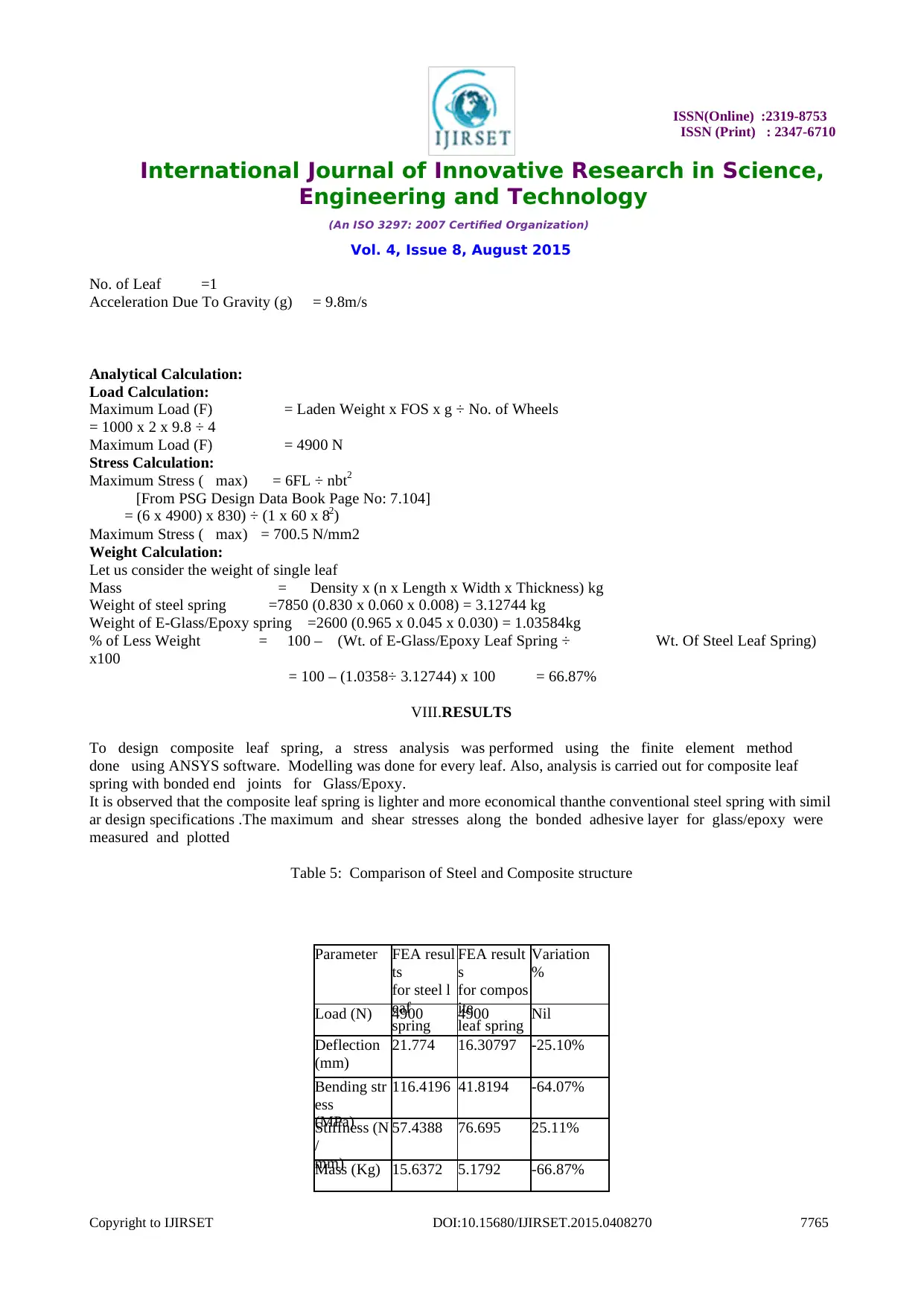
ISSN(Online) :2319-8753
ISSN (Print) : 2347-6710
International Journal of Innovative Research in Science,
Engineering and Technology
(An ISO 3297: 2007 Certified Organization)
Vol. 4, Issue 8, August 2015
Copyright to IJIRSET DOI:10.15680/IJIRSET.2015.0408270 7765
No. of Leaf =1
Acceleration Due To Gravity (g) = 9.8m/s
Analytical Calculation:
Load Calculation:
Maximum Load (F) = Laden Weight x FOS x g ÷ No. of Wheels
= 1000 x 2 x 9.8 ÷ 4
Maximum Load (F) = 4900 N
Stress Calculation:
Maximum Stress (max) = 6FL ÷ nbt2
[From PSG Design Data Book Page No: 7.104]
= (6 x 4900) x 830) ÷ (1 x 60 x 82)
Maximum Stress (max) = 700.5 N/mm2
Weight Calculation:
Let us consider the weight of single leaf
Mass = Density x (n x Length x Width x Thickness) kg
Weight of steel spring =7850 (0.830 x 0.060 x 0.008) = 3.12744 kg
Weight of E-Glass/Epoxy spring =2600 (0.965 x 0.045 x 0.030) = 1.03584kg
% of Less Weight = 100 – (Wt. of E-Glass/Epoxy Leaf Spring ÷ Wt. Of Steel Leaf Spring)
x100
= 100 – (1.0358÷ 3.12744) x 100 = 66.87%
VIII.RESULTS
To design composite leaf spring, a stress analysis was performed using the finite element method
done using ANSYS software. Modelling was done for every leaf. Also, analysis is carried out for composite leaf
spring with bonded end joints for Glass/Epoxy.
It is observed that the composite leaf spring is lighter and more economical thanthe conventional steel spring with simil
ar design specifications .The maximum and shear stresses along the bonded adhesive layer for glass/epoxy were
measured and plotted
Table 5: Comparison of Steel and Composite structure
Parameter FEA resul
ts
for steel l
eaf
spring
FEA result
s
for compos
ite
leaf spring
Variation
%
Load (N) 4900 4900 Nil
Deflection
(mm)
21.774 16.30797 -25.10%
Bending str
ess
(MPa)
116.4196 41.8194 -64.07%
Stiffness (N
/
mm)
57.4388 76.695 25.11%
Mass (Kg) 15.6372 5.1792 -66.87%
ISSN (Print) : 2347-6710
International Journal of Innovative Research in Science,
Engineering and Technology
(An ISO 3297: 2007 Certified Organization)
Vol. 4, Issue 8, August 2015
Copyright to IJIRSET DOI:10.15680/IJIRSET.2015.0408270 7765
No. of Leaf =1
Acceleration Due To Gravity (g) = 9.8m/s
Analytical Calculation:
Load Calculation:
Maximum Load (F) = Laden Weight x FOS x g ÷ No. of Wheels
= 1000 x 2 x 9.8 ÷ 4
Maximum Load (F) = 4900 N
Stress Calculation:
Maximum Stress (max) = 6FL ÷ nbt2
[From PSG Design Data Book Page No: 7.104]
= (6 x 4900) x 830) ÷ (1 x 60 x 82)
Maximum Stress (max) = 700.5 N/mm2
Weight Calculation:
Let us consider the weight of single leaf
Mass = Density x (n x Length x Width x Thickness) kg
Weight of steel spring =7850 (0.830 x 0.060 x 0.008) = 3.12744 kg
Weight of E-Glass/Epoxy spring =2600 (0.965 x 0.045 x 0.030) = 1.03584kg
% of Less Weight = 100 – (Wt. of E-Glass/Epoxy Leaf Spring ÷ Wt. Of Steel Leaf Spring)
x100
= 100 – (1.0358÷ 3.12744) x 100 = 66.87%
VIII.RESULTS
To design composite leaf spring, a stress analysis was performed using the finite element method
done using ANSYS software. Modelling was done for every leaf. Also, analysis is carried out for composite leaf
spring with bonded end joints for Glass/Epoxy.
It is observed that the composite leaf spring is lighter and more economical thanthe conventional steel spring with simil
ar design specifications .The maximum and shear stresses along the bonded adhesive layer for glass/epoxy were
measured and plotted
Table 5: Comparison of Steel and Composite structure
Parameter FEA resul
ts
for steel l
eaf
spring
FEA result
s
for compos
ite
leaf spring
Variation
%
Load (N) 4900 4900 Nil
Deflection
(mm)
21.774 16.30797 -25.10%
Bending str
ess
(MPa)
116.4196 41.8194 -64.07%
Stiffness (N
/
mm)
57.4388 76.695 25.11%
Mass (Kg) 15.6372 5.1792 -66.87%
⊘ This is a preview!⊘
Do you want full access?
Subscribe today to unlock all pages.

Trusted by 1+ million students worldwide
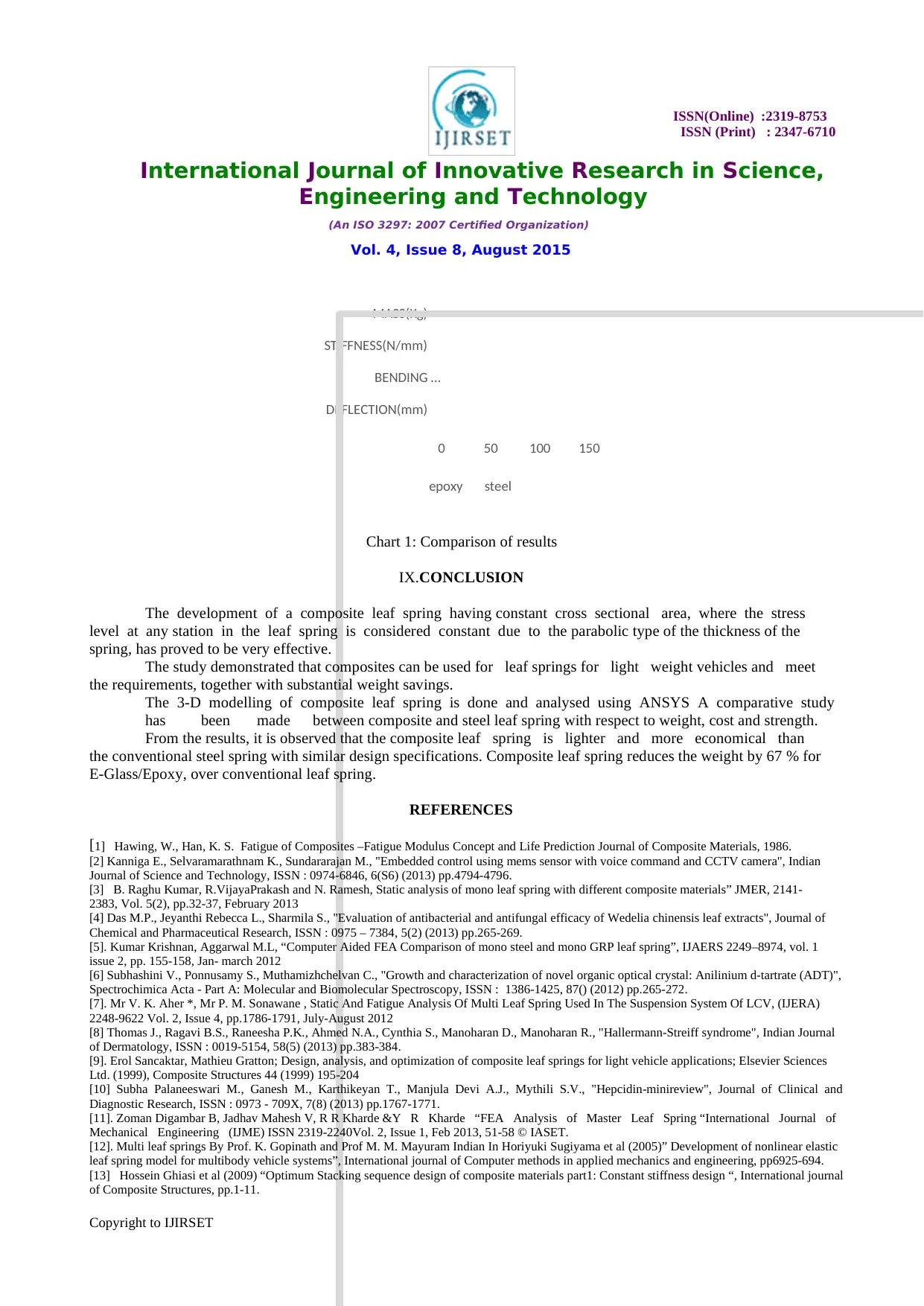
ISSN(Online) :2319-8753
ISSN (Print) : 2347-6710
International Journal of Innovative Research in Science,
Engineering and Technology
(An ISO 3297: 2007 Certified Organization)
Vol. 4, Issue 8, August 2015
Copyright to IJIRSET DOI:10.15680/IJIRSET.2015.0408270 7766
0 50 100 150
DEFLECTION(mm)
BENDING …
STIFFNESS(N/mm)
MASS(Kg)
epoxy steel
Chart 1: Comparison of results
IX.CONCLUSION
The development of a composite leaf spring having constant cross sectional area, where the stress
level at any station in the leaf spring is considered constant due to the parabolic type of the thickness of the
spring, has proved to be very effective.
The study demonstrated that composites can be used for leaf springs for light weight vehicles and meet
the requirements, together with substantial weight savings.
The 3-D modelling of composite leaf spring is done and analysed using ANSYS A comparative study
has been made between composite and steel leaf spring with respect to weight, cost and strength.
From the results, it is observed that the composite leaf spring is lighter and more economical than
the conventional steel spring with similar design specifications. Composite leaf spring reduces the weight by 67 % for
E-Glass/Epoxy, over conventional leaf spring.
REFERENCES
[1] Hawing, W., Han, K. S. Fatigue of Composites –Fatigue Modulus Concept and Life Prediction Journal of Composite Materials, 1986.
[2] Kanniga E., Selvaramarathnam K., Sundararajan M., "Embedded control using mems sensor with voice command and CCTV camera", Indian
Journal of Science and Technology, ISSN : 0974-6846, 6(S6) (2013) pp.4794-4796.
[3] B. Raghu Kumar, R.VijayaPrakash and N. Ramesh, Static analysis of mono leaf spring with different composite materials” JMER, 2141-
2383, Vol. 5(2), pp.32-37, February 2013
[4] Das M.P., Jeyanthi Rebecca L., Sharmila S., "Evaluation of antibacterial and antifungal efficacy of Wedelia chinensis leaf extracts", Journal of
Chemical and Pharmaceutical Research, ISSN : 0975 – 7384, 5(2) (2013) pp.265-269.
[5]. Kumar Krishnan, Aggarwal M.L, “Computer Aided FEA Comparison of mono steel and mono GRP leaf spring”, IJAERS 2249–8974, vol. 1
issue 2, pp. 155-158, Jan- march 2012
[6] Subhashini V., Ponnusamy S., Muthamizhchelvan C., "Growth and characterization of novel organic optical crystal: Anilinium d-tartrate (ADT)",
Spectrochimica Acta - Part A: Molecular and Biomolecular Spectroscopy, ISSN : 1386-1425, 87() (2012) pp.265-272.
[7]. Mr V. K. Aher *, Mr P. M. Sonawane , Static And Fatigue Analysis Of Multi Leaf Spring Used In The Suspension System Of LCV, (IJERA)
2248-9622 Vol. 2, Issue 4, pp.1786-1791, July-August 2012
[8] Thomas J., Ragavi B.S., Raneesha P.K., Ahmed N.A., Cynthia S., Manoharan D., Manoharan R., "Hallermann-Streiff syndrome", Indian Journal
of Dermatology, ISSN : 0019-5154, 58(5) (2013) pp.383-384.
[9]. Erol Sancaktar, Mathieu Gratton; Design, analysis, and optimization of composite leaf springs for light vehicle applications; Elsevier Sciences
Ltd. (1999), Composite Structures 44 (1999) 195-204
[10] Subha Palaneeswari M., Ganesh M., Karthikeyan T., Manjula Devi A.J., Mythili S.V., "Hepcidin-minireview", Journal of Clinical and
Diagnostic Research, ISSN : 0973 - 709X, 7(8) (2013) pp.1767-1771.
[11]. Zoman Digambar B, Jadhav Mahesh V, R R Kharde &Y R Kharde “FEA Analysis of Master Leaf Spring “International Journal of
Mechanical Engineering (IJME) ISSN 2319-2240Vol. 2, Issue 1, Feb 2013, 51-58 © IASET.
[12]. Multi leaf springs By Prof. K. Gopinath and Prof M. M. Mayuram Indian In Horiyuki Sugiyama et al (2005)” Development of nonlinear elastic
leaf spring model for multibody vehicle systems”, International journal of Computer methods in applied mechanics and engineering, pp6925-694.
[13] Hossein Ghiasi et al (2009) “Optimum Stacking sequence design of composite materials part1: Constant stiffness design “, International journal
of Composite Structures, pp.1-11.
ISSN (Print) : 2347-6710
International Journal of Innovative Research in Science,
Engineering and Technology
(An ISO 3297: 2007 Certified Organization)
Vol. 4, Issue 8, August 2015
Copyright to IJIRSET DOI:10.15680/IJIRSET.2015.0408270 7766
0 50 100 150
DEFLECTION(mm)
BENDING …
STIFFNESS(N/mm)
MASS(Kg)
epoxy steel
Chart 1: Comparison of results
IX.CONCLUSION
The development of a composite leaf spring having constant cross sectional area, where the stress
level at any station in the leaf spring is considered constant due to the parabolic type of the thickness of the
spring, has proved to be very effective.
The study demonstrated that composites can be used for leaf springs for light weight vehicles and meet
the requirements, together with substantial weight savings.
The 3-D modelling of composite leaf spring is done and analysed using ANSYS A comparative study
has been made between composite and steel leaf spring with respect to weight, cost and strength.
From the results, it is observed that the composite leaf spring is lighter and more economical than
the conventional steel spring with similar design specifications. Composite leaf spring reduces the weight by 67 % for
E-Glass/Epoxy, over conventional leaf spring.
REFERENCES
[1] Hawing, W., Han, K. S. Fatigue of Composites –Fatigue Modulus Concept and Life Prediction Journal of Composite Materials, 1986.
[2] Kanniga E., Selvaramarathnam K., Sundararajan M., "Embedded control using mems sensor with voice command and CCTV camera", Indian
Journal of Science and Technology, ISSN : 0974-6846, 6(S6) (2013) pp.4794-4796.
[3] B. Raghu Kumar, R.VijayaPrakash and N. Ramesh, Static analysis of mono leaf spring with different composite materials” JMER, 2141-
2383, Vol. 5(2), pp.32-37, February 2013
[4] Das M.P., Jeyanthi Rebecca L., Sharmila S., "Evaluation of antibacterial and antifungal efficacy of Wedelia chinensis leaf extracts", Journal of
Chemical and Pharmaceutical Research, ISSN : 0975 – 7384, 5(2) (2013) pp.265-269.
[5]. Kumar Krishnan, Aggarwal M.L, “Computer Aided FEA Comparison of mono steel and mono GRP leaf spring”, IJAERS 2249–8974, vol. 1
issue 2, pp. 155-158, Jan- march 2012
[6] Subhashini V., Ponnusamy S., Muthamizhchelvan C., "Growth and characterization of novel organic optical crystal: Anilinium d-tartrate (ADT)",
Spectrochimica Acta - Part A: Molecular and Biomolecular Spectroscopy, ISSN : 1386-1425, 87() (2012) pp.265-272.
[7]. Mr V. K. Aher *, Mr P. M. Sonawane , Static And Fatigue Analysis Of Multi Leaf Spring Used In The Suspension System Of LCV, (IJERA)
2248-9622 Vol. 2, Issue 4, pp.1786-1791, July-August 2012
[8] Thomas J., Ragavi B.S., Raneesha P.K., Ahmed N.A., Cynthia S., Manoharan D., Manoharan R., "Hallermann-Streiff syndrome", Indian Journal
of Dermatology, ISSN : 0019-5154, 58(5) (2013) pp.383-384.
[9]. Erol Sancaktar, Mathieu Gratton; Design, analysis, and optimization of composite leaf springs for light vehicle applications; Elsevier Sciences
Ltd. (1999), Composite Structures 44 (1999) 195-204
[10] Subha Palaneeswari M., Ganesh M., Karthikeyan T., Manjula Devi A.J., Mythili S.V., "Hepcidin-minireview", Journal of Clinical and
Diagnostic Research, ISSN : 0973 - 709X, 7(8) (2013) pp.1767-1771.
[11]. Zoman Digambar B, Jadhav Mahesh V, R R Kharde &Y R Kharde “FEA Analysis of Master Leaf Spring “International Journal of
Mechanical Engineering (IJME) ISSN 2319-2240Vol. 2, Issue 1, Feb 2013, 51-58 © IASET.
[12]. Multi leaf springs By Prof. K. Gopinath and Prof M. M. Mayuram Indian In Horiyuki Sugiyama et al (2005)” Development of nonlinear elastic
leaf spring model for multibody vehicle systems”, International journal of Computer methods in applied mechanics and engineering, pp6925-694.
[13] Hossein Ghiasi et al (2009) “Optimum Stacking sequence design of composite materials part1: Constant stiffness design “, International journal
of Composite Structures, pp.1-11.
Paraphrase This Document
Need a fresh take? Get an instant paraphrase of this document with our AI Paraphraser
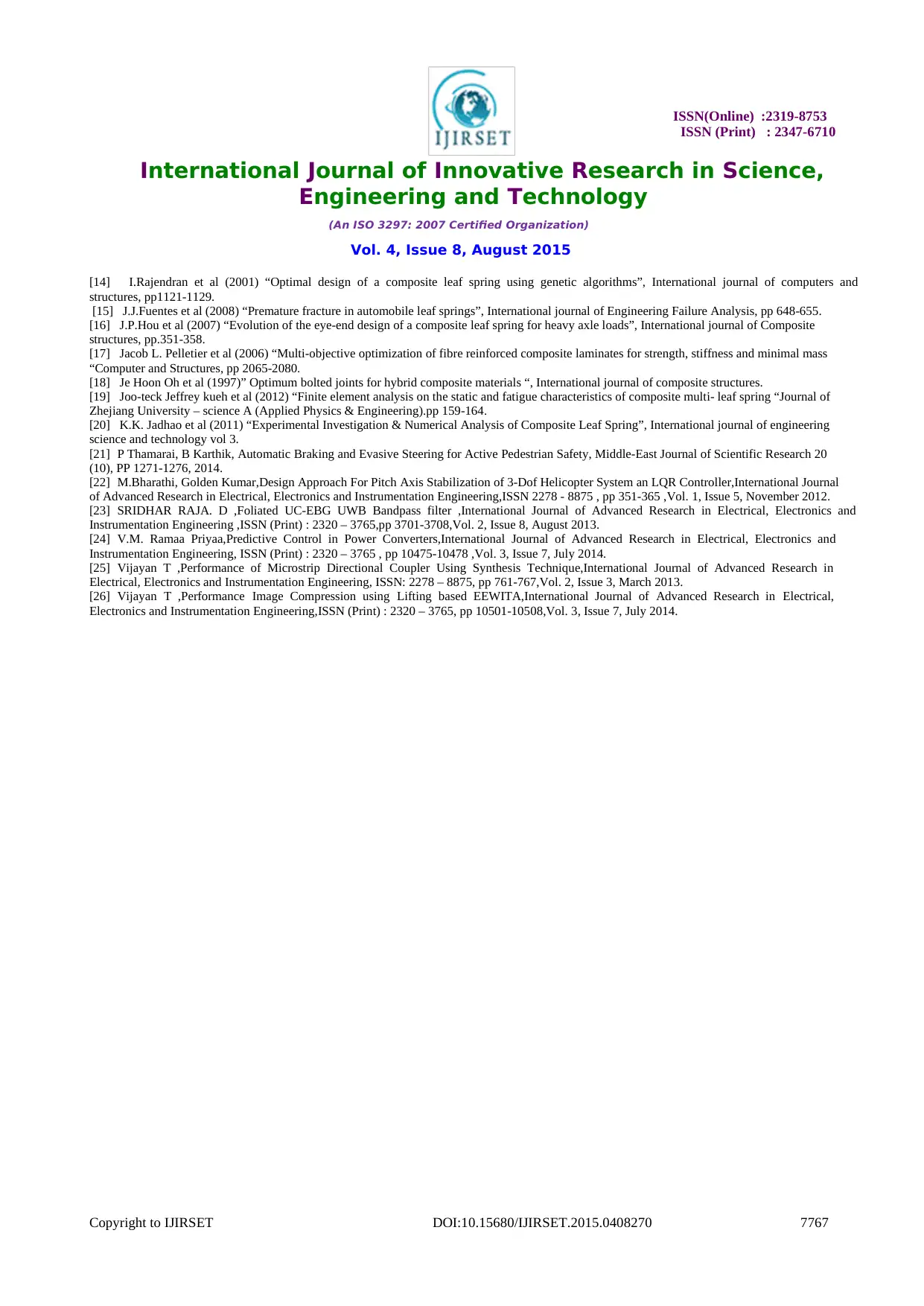
ISSN(Online) :2319-8753
ISSN (Print) : 2347-6710
International Journal of Innovative Research in Science,
Engineering and Technology
(An ISO 3297: 2007 Certified Organization)
Vol. 4, Issue 8, August 2015
Copyright to IJIRSET DOI:10.15680/IJIRSET.2015.0408270 7767
[14] I.Rajendran et al (2001) “Optimal design of a composite leaf spring using genetic algorithms”, International journal of computers and
structures, pp1121-1129.
[15] J.J.Fuentes et al (2008) “Premature fracture in automobile leaf springs”, International journal of Engineering Failure Analysis, pp 648-655.
[16] J.P.Hou et al (2007) “Evolution of the eye-end design of a composite leaf spring for heavy axle loads”, International journal of Composite
structures, pp.351-358.
[17] Jacob L. Pelletier et al (2006) “Multi-objective optimization of fibre reinforced composite laminates for strength, stiffness and minimal mass
“Computer and Structures, pp 2065-2080.
[18] Je Hoon Oh et al (1997)” Optimum bolted joints for hybrid composite materials “, International journal of composite structures.
[19] Joo-teck Jeffrey kueh et al (2012) “Finite element analysis on the static and fatigue characteristics of composite multi- leaf spring “Journal of
Zhejiang University – science A (Applied Physics & Engineering).pp 159-164.
[20] K.K. Jadhao et al (2011) “Experimental Investigation & Numerical Analysis of Composite Leaf Spring”, International journal of engineering
science and technology vol 3.
[21] P Thamarai, B Karthik, Automatic Braking and Evasive Steering for Active Pedestrian Safety, Middle-East Journal of Scientific Research 20
(10), PP 1271-1276, 2014.
[22] M.Bharathi, Golden Kumar,Design Approach For Pitch Axis Stabilization of 3-Dof Helicopter System an LQR Controller,International Journal
of Advanced Research in Electrical, Electronics and Instrumentation Engineering,ISSN 2278 - 8875 , pp 351-365 ,Vol. 1, Issue 5, November 2012.
[23] SRIDHAR RAJA. D ,Foliated UC-EBG UWB Bandpass filter ,International Journal of Advanced Research in Electrical, Electronics and
Instrumentation Engineering ,ISSN (Print) : 2320 – 3765,pp 3701-3708,Vol. 2, Issue 8, August 2013.
[24] V.M. Ramaa Priyaa,Predictive Control in Power Converters,International Journal of Advanced Research in Electrical, Electronics and
Instrumentation Engineering, ISSN (Print) : 2320 – 3765 , pp 10475-10478 ,Vol. 3, Issue 7, July 2014.
[25] Vijayan T ,Performance of Microstrip Directional Coupler Using Synthesis Technique,International Journal of Advanced Research in
Electrical, Electronics and Instrumentation Engineering, ISSN: 2278 – 8875, pp 761-767,Vol. 2, Issue 3, March 2013.
[26] Vijayan T ,Performance Image Compression using Lifting based EEWITA,International Journal of Advanced Research in Electrical,
Electronics and Instrumentation Engineering,ISSN (Print) : 2320 – 3765, pp 10501-10508,Vol. 3, Issue 7, July 2014.
ISSN (Print) : 2347-6710
International Journal of Innovative Research in Science,
Engineering and Technology
(An ISO 3297: 2007 Certified Organization)
Vol. 4, Issue 8, August 2015
Copyright to IJIRSET DOI:10.15680/IJIRSET.2015.0408270 7767
[14] I.Rajendran et al (2001) “Optimal design of a composite leaf spring using genetic algorithms”, International journal of computers and
structures, pp1121-1129.
[15] J.J.Fuentes et al (2008) “Premature fracture in automobile leaf springs”, International journal of Engineering Failure Analysis, pp 648-655.
[16] J.P.Hou et al (2007) “Evolution of the eye-end design of a composite leaf spring for heavy axle loads”, International journal of Composite
structures, pp.351-358.
[17] Jacob L. Pelletier et al (2006) “Multi-objective optimization of fibre reinforced composite laminates for strength, stiffness and minimal mass
“Computer and Structures, pp 2065-2080.
[18] Je Hoon Oh et al (1997)” Optimum bolted joints for hybrid composite materials “, International journal of composite structures.
[19] Joo-teck Jeffrey kueh et al (2012) “Finite element analysis on the static and fatigue characteristics of composite multi- leaf spring “Journal of
Zhejiang University – science A (Applied Physics & Engineering).pp 159-164.
[20] K.K. Jadhao et al (2011) “Experimental Investigation & Numerical Analysis of Composite Leaf Spring”, International journal of engineering
science and technology vol 3.
[21] P Thamarai, B Karthik, Automatic Braking and Evasive Steering for Active Pedestrian Safety, Middle-East Journal of Scientific Research 20
(10), PP 1271-1276, 2014.
[22] M.Bharathi, Golden Kumar,Design Approach For Pitch Axis Stabilization of 3-Dof Helicopter System an LQR Controller,International Journal
of Advanced Research in Electrical, Electronics and Instrumentation Engineering,ISSN 2278 - 8875 , pp 351-365 ,Vol. 1, Issue 5, November 2012.
[23] SRIDHAR RAJA. D ,Foliated UC-EBG UWB Bandpass filter ,International Journal of Advanced Research in Electrical, Electronics and
Instrumentation Engineering ,ISSN (Print) : 2320 – 3765,pp 3701-3708,Vol. 2, Issue 8, August 2013.
[24] V.M. Ramaa Priyaa,Predictive Control in Power Converters,International Journal of Advanced Research in Electrical, Electronics and
Instrumentation Engineering, ISSN (Print) : 2320 – 3765 , pp 10475-10478 ,Vol. 3, Issue 7, July 2014.
[25] Vijayan T ,Performance of Microstrip Directional Coupler Using Synthesis Technique,International Journal of Advanced Research in
Electrical, Electronics and Instrumentation Engineering, ISSN: 2278 – 8875, pp 761-767,Vol. 2, Issue 3, March 2013.
[26] Vijayan T ,Performance Image Compression using Lifting based EEWITA,International Journal of Advanced Research in Electrical,
Electronics and Instrumentation Engineering,ISSN (Print) : 2320 – 3765, pp 10501-10508,Vol. 3, Issue 7, July 2014.
1 out of 11
Related Documents
Your All-in-One AI-Powered Toolkit for Academic Success.
+13062052269
info@desklib.com
Available 24*7 on WhatsApp / Email
![[object Object]](/_next/static/media/star-bottom.7253800d.svg)
Unlock your academic potential
Copyright © 2020–2025 A2Z Services. All Rights Reserved. Developed and managed by ZUCOL.




